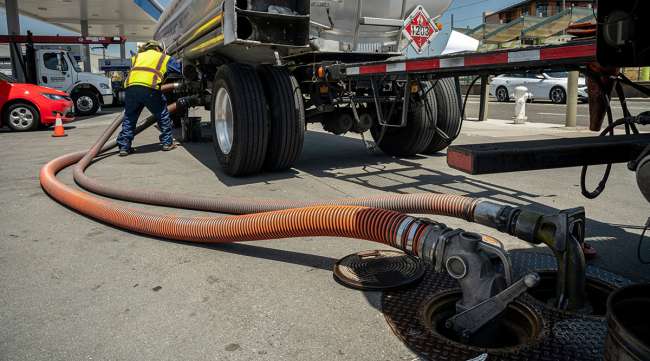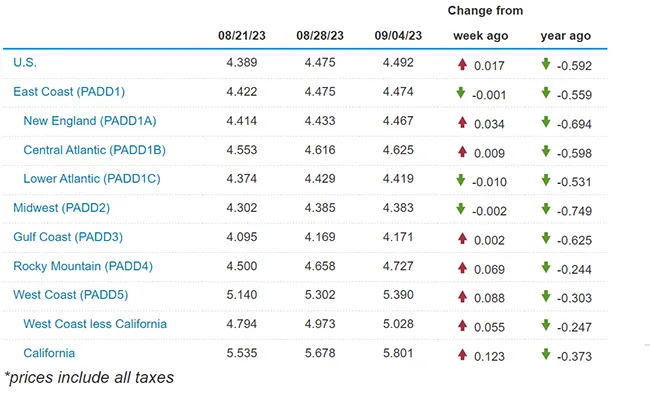Senior Reporter
Diesel Prices Up 1.7¢ in Seventh Straight Increase

[Stay on top of transportation news: Get TTNews in your inbox.]
Diesel prices climbed for the seventh week in a row, although the increase was a modest 1.7 cents a gallon nationally, according to information from the Energy Information Administration released Sept. 5.
For the week ending Sept. 4, the national average bumped up to $4.492 a gallon, which is 59.2 cents a gallon cheaper than a year ago.
But in some regions, the average price dropped: Lower Atlantic (1 cent), Midwest (0.2 cent) and East Coast (0.1 cent).
It rose in the other seven regions, led by a 12.3-cent surge in California, where diesel is now back up to $5.801 a gallon.
Diesel remains cheapest in the Gulf Coast region at $4.171 a gallon.

Source: EIA.gov
Gasoline shifted slightly upward as well, rising 0.6 cent to $3.807 a gallon for the national average, which is 6.1 cents a gallon more than a year ago.
In an effort to keep worldwide oil prices at the level they are now, Saudi Arabia on Sept. 5 said it would extend until the end of 2023 its voluntary 1 million-barrel-per-day production cut that it had instituted on a month-to-month basis.
The reduction is on top of a 1.66 million-barrel-per-day reduction that other members of the oil-producing cartel OPEC+ had imposed until the end of 2024.
The Saudi reduction means that nation’s oil production output will remain at nearly 9 million barrels per day for the remainder of 2023.
The production cuts, increased demand for oil and the peak of the U.S. hurricane season are having an impact on price.
After spending more of 2023 below $75 a barrel, the price of crude jumped by more than $10 over the summer to more than $86 a barrel.
U.S. average on-highway #diesel fuel price on September 4, 2023 was $4.492/gallon, UP 1.7¢/gallon from 8/28/23, DOWN 59.2¢/gallon from year ago #truckers #shippers #fuelprices https://t.co/lPvRNZFztg pic.twitter.com/eWl8UDU7q5 — EIA (@EIAgov) September 6, 2023
U.S. average price for regular-grade #gasoline on September 4, 2023 was $3.807/gal, DOWN 0.6¢/gallon from 8/28/23, UP 6.1¢/gallon from year ago #gasprices https://t.co/jZphFa0hDF pic.twitter.com/S3zBkoNyY7 — EIA (@EIAgov) September 6, 2023
Oil industry analyst Phil Flynn said that the OPEC+ nations and the Biden administration are engaged in a high-stakes game of energy chicken.
“Russia and Saudi Arabia are using their energy reserves to get what they want, and that’s higher energy prices because they felt it was undervalued,” he said, noting that the oil-producing nations cut their production after President Joe Biden announced the U.S. would release millions of barrels of oil from the nation’s Strategic Petroleum Reserve earlier this year, lowering prices temporarily. “This is payback. This is an opportunity for them to get prices higher, but it could backfire on them,” Flynn said. “If they get prices too high, we’ll increase domestic oil production here.”
On Sept. 5, Russia also announced it would extend its 300,000-barrel-per-day production cuts through the end of the year; the country’s oil production in July remained flat at 9.42 million barrels per day.
Even while the EIA is also forecasting that domestic oil production will increase during the remainder of 2023 and into 2024 to more than 13 million barrels per day, which is above pre-COVID levels, the weekly Baker-Hughes rig count shows a significant year-over-year drop. Drilling ramped up last year as workers returned to work and the economy roared out of the pandemic.

Transport Topics' Seth Clevenger, Michael Freeze and Mike Senatore dissect the new Top 100 list of the largest private carriers, including how fleets are adapting to this softened market. Tune in above or by going to RoadSigns.ttnews.com.
Baker-Hughes says 631 rigs were in operation last week, down one from the previous week, but declining by 129 since Sept. 2, 2022.
An analysis by S&P Global Commodity Insights shows that after reaching a post-pandemic high at 889 in November 2022, the U.S. drilling fleet has now contracted by more than 20% in nine months, as domestic oil and gas producers continue to respond to weaker commodity prices. The report said that through late August, the U.S. benchmark fuel, West Texas Intermediate, has averaged $78.26 a barrel, down from an average of $100.36 during the same eight-month period in 2022.
Meanwhile, a new report from the EIA says the production capacity of renewable diesel and other biofuels reached 3 billion gallons per year in January, marking the first time production of the fuel product has exceeded capacity. In its report, the EIA said that rising targets for state and federal renewable fuel programs and the renewal of biomass-based diesel tax credits are driving this growth in U.S. renewable diesel capacity.
“Since 2021, renewable diesel and other biofuels production capacity has more than tripled in the United States,” EIA wrote. “Nationwide, overall biofuels production capacity — which includes renewable diesel, biodiesel, ethanol and other biofuels — reached 23 billion gallons per year in January 2023, a 6% increase in total production capacity from January 2022.”
According to the EIA, most light-, medium-, and heavy-duty diesel vehicles are not technically alternative fuel vehicles, but almost all are capable of running on biodiesel blends. The most common biodiesel blend is B20, which ranges from 6% to 20% biodiesel blended with petroleum diesel.
Want more news? Listen to today's daily briefing below or go here for more info:




